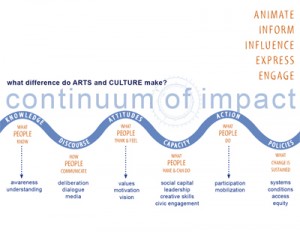Blog
Evaluating the impact of storytelling

It is difficult, even impossible, for organizations to conclusively answer broad questions about their impact, such as “How has the zeitgeist on criminal justice changed because of your film?” Instead, organizations might identify more specifically where impact can be observed.
Animating Democracy—a  program of Americans for the Arts that fosters civic engagement through arts and culture—has created a framework for understanding the “Social Impact Indicators” of the arts. These indicators are part of a larger set of Animating Democracy resources on the impact of the arts.
program of Americans for the Arts that fosters civic engagement through arts and culture—has created a framework for understanding the “Social Impact Indicators” of the arts. These indicators are part of a larger set of Animating Democracy resources on the impact of the arts.
Following are the categories of indicators, with examples of projects profiled in the first edition of the Narrative Arts guide on “Storytelling and Social Change.”
- Knowledge: People gain new awareness and understanding. Example: Participants in a Cornerstone Theater Company production learn about immigrant communities.
- Discourse: People communicate in new ways, whether through deliberation, dialogue, or media. Example: The Neighborhood Story Project’s books and public events generate grassroots dialogue about issues facing New Orleans.
- Attitudes: Individuals change how they think and feel. Example: Young LGBT viewers of the It Gets Better Project videos feel more hopeful about their futures. Often, attitudinal change is a precursor to action—those LGBT youth will commit suicide at lower rates—but it can also be a social good in its own right.
- Capacity: People experience a change in what they can have and do, be it social capital, leadership, creative skills, or civic engagement. Example: The Orton Family Foundation’s “Heart & Soul” method for community planning helps foster new community partnerships.
- Action: Individuals behave in a new way, such as by voting, donating, volunteering, taking some other positive action, or stopping a harmful action. Example: With funding from the Open Society Foundations, KHSIMA has a story-driven campaign that helps teachers integrate students with intellectual disabilities into the classroom, or prompt the students’ classmates to act more tolerantly towards them.
- Policies: Corporations, governments, or other entities change their policies, procedures, or practices—all of which affect what and how change is sustained. Example: Nation Inside hosts a story-driven campaign that successfully pushed for policy changes that lowered what it called the “exorbitant” rates of phone calls between prisoners and their loved ones.
Depending on the type of impact, the mechanisms of evaluation may include surveys, focus groups, comments on social media, voting patterns, web traffic data, fundraising data, or reviews of policy changes.
